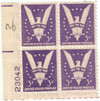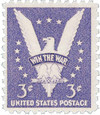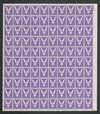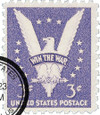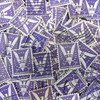
1942 3c Win the War
# 905 - 1942 3c Win the War
$0.35 - $40.00
U.S. #905
3¢ Win the War
3¢ Win the War
Issue Date: July 4, 1942
City: Washington, D.C.
Quantity: 20,642,793,310
Printed by: Bureau of Engraving and Printing
Printing Method: Rotary Press
Perforations: 11 x 10.5
Color: Violet
City: Washington, D.C.
Quantity: 20,642,793,310
Printed by: Bureau of Engraving and Printing
Printing Method: Rotary Press
Perforations: 11 x 10.5
Color: Violet
U.S. #905, the Win the War stamp, was issued on the anniversary of American independence in order to bolster American support of the war effort.
This stamp was honored in the 100 Greatest U.S. Stamps book.
U.S. #905
3¢ Win the War
3¢ Win the War
Issue Date: July 4, 1942
City: Washington, D.C.
Quantity: 20,642,793,310
Printed by: Bureau of Engraving and Printing
Printing Method: Rotary Press
Perforations: 11 x 10.5
Color: Violet
City: Washington, D.C.
Quantity: 20,642,793,310
Printed by: Bureau of Engraving and Printing
Printing Method: Rotary Press
Perforations: 11 x 10.5
Color: Violet
U.S. #905, the Win the War stamp, was issued on the anniversary of American independence in order to bolster American support of the war effort.
This stamp was honored in the 100 Greatest U.S. Stamps book.



